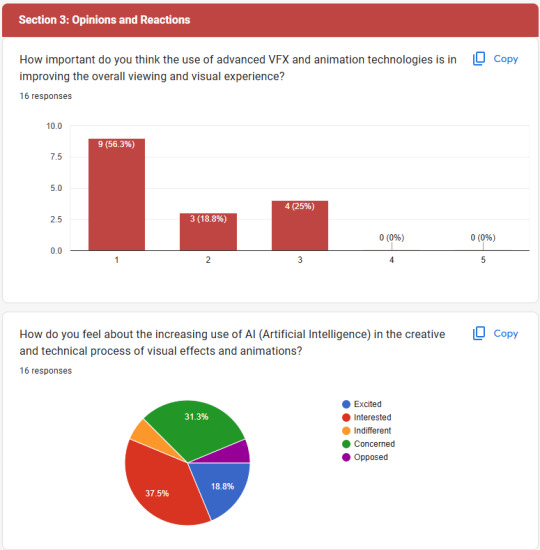Don't wanna be here? Send us removal request.
Text
New, Updated and Final CV
I tweaked a few things in my CV to make it more presentable. I increased the text size and removed unnecessary information. I added more detail to my software skills, as I felt it was important to showcase this ability more prominently since it's fundamental to my work. Other changes included formatting and placement adjustments.
New CV

Old CV

0 notes
Text
The Completed Essay
The Final Essay—it feels crazy to even say those words. It's been a while since this module first started, and it wasn't the easiest to grasp due to its quite professional and academic nature (hence the name, obviously).
I was pretty determined to show my best self when it came to this task since I've been adept at writing from a young age. However, I haven't written in a while, so brushing up my skills was one of the biggest challenges for me with this module, as well as producing a paper that was both interesting to read and informative.
This final paper is a culmination of everything I've learned throughout this year. Writing skills aside, it showcases my ability to research, grasp information, and transfer complex ideas into an easy-to-read format. New changes include adding page numbers and making a few formatting adjustments, such as character sizing, text wrapping, and page layout, as suggested by my lecturer.

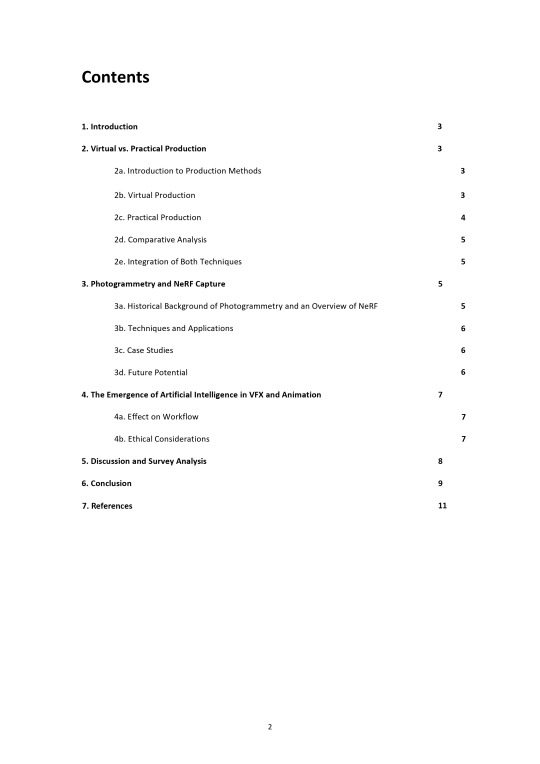









0 notes
Text
The Final Draft
After several days of editing and rewriting, I finally managed to put together a final draft. I already knew that it still needed a few tweaks when it came to formatting, but it was mostly done. I had tried my best to make the research paper as academic and professionally put together as possible, with an air of scholarship.
It has a cover page, followed by a contents page which outlines the different subsections of the paper (I was yet to add page numbers at this point, which was a note I had made to myself earlier).
Each picture has a figure caption under it, making it easier for readers to locate and identify the images. Adequate character and line spacing makes the paper readable to an academic standard, while keeping an aesthetic look.
I am quite pleased with how this has come along, hoping to make a few changes with the feedback I will get from my lecturer in the days to come.










0 notes
Text
Class Task: Curriculum Vitae
We had to make a CV for a job application since we have to apply for internships later down the semester. I had opted to make two, one with a more stylized look that highlights my graphic design prowess as well as a more standard, minimal and corporate CV that outlines my work in a clear cut manner.
I do believe both CVs hold great merit in their own right, one excelling in showcasing my above average understanding of graphic design elements as well as the other that is a lot more adept and organized.
Overall this was a great learning experience for me to understand the inner workings and professional aspects of making a CV and it gave me an opportunity to look into real life professionals and how they conduct a briefing while looking for hiring prospects. I didn't have to look too far to gain this insight as my older sister works very closely with Talent Management and Human Resources at her workplace.


ps. references, contact details as well as other personal information are just placeholders for now - I will be updating it with accurate information when sending it over to a company.
0 notes
Text
Primary Research: Questionnaire
Introduction: Hello! I'm conducting a survey to understand public perceptions of new technologies in visual effects (VFX) and animation. Your responses will help in exploring how these advancements are influencing audience experiences. This survey will take about 5-10 minutes. Thank you for your time!
Section 1: General Information
Age:
Under 18
18-24
25-34
35-44
45-54
55-64
65 and over
Gender:
Male
Female
Other/Prefer not to say
How often do you watch movies or TV shows?
Daily
Several times a week
Once a week
A few times a month
Rarely
Section 2: Awareness and Perceptions
4. How familiar are you with the following terms?
Virtual Production Photogrammetry Neural Radiance Fields (NeRF) Artificial Intelligence (AI) in VFX
Have you ever watched content (movies, TV shows, etc.) that you know used advanced VFX or animation technologies like those mentioned above?
Yes
No
Not sure
Section 3: Opinions and Reactions
How important do you think the use of advanced VFX and animation technologies is in improving the overall viewing experience?
Very important
Important
Somewhat important
Not important
Do you think the visual quality of movies and TV shows has improved with the use of new VFX technologies?
Strongly agree
Agree
Neutral
Disagree
Strongly disagree
How do you feel about the increasing use of AI in creating visual effects and animations?
Excited
Interested
Indifferent
Concerned
Opposed
In your opinion, does the use of these new technologies (e.g., virtual production, AI) enhance or detract from the storytelling in movies and TV shows?
Greatly enhances
Somewhat enhances
No impact
Somewhat detracts
Greatly detracts
How likely are you to watch a movie or TV show that heavily advertises its use of cutting-edge VFX and animation technologies?
Very likely
Likely
Neutral
Unlikely
Very unlikely
Section 4: Future Implications 1. Do you think that advancements in VFX and animation technology will continue to significantly influence the entertainment industry in the next 5-10 years? - Strongly agree - Agree - Neutral - Disagree - Strongly disagree 2. Would you be interested in learning more about how these technologies work and their impact on the industry?
Very interested
Interested
Neutral
Not interested
3. Do you have any concerns about the rapid advancement of technology in VFX and animation? (Select all that apply)
Loss of traditional filmmaking techniques Ethical concerns (e.g., deep fakes) Over-reliance on technology Impact on employment in the industry No concerns Other (please specify)
Section 5: Open-Ended Questions
What is one movie or TV show that you feel has particularly impressive visual effects? What stood out to you about its VFX?
Do you have any additional comments or thoughts on the future of VFX and animation technology?
0 notes
Text
Research: Rise of AI in the VFX industry
The LinkedIn article "Unleashing the Potential of Artificial Intelligence in the VFX and Animation Industry" explores the transformative impact of AI on this creative field. Key points include:
AI's Expanding Role: AI is revolutionizing VFX and animation by automating repetitive tasks, enhancing efficiency, and enabling new creative possibilities.
Enhanced Workflows: AI-powered tools streamline production processes, from rotoscoping and object tracking to character animation and scene generation. This allows artists to focus on more complex and creative aspects of their work.
Real-Time Rendering: Advances in real-time rendering engines, like Unreal Engine, provide instant feedback and accelerate production timelines.
Immersive Technologies: AI is playing a crucial role in developing immersive experiences like Augmented Reality (AR) and Virtual Reality (VR). These technologies are transforming storytelling and audience engagement.
Increased Demand for Content: The surge in streaming platforms and the demand for high-quality visuals have led to increased opportunities for VFX and animation professionals.
Challenges and Opportunities: While AI presents challenges like potential job displacement, it also offers immense opportunities for artists to learn new skills and adapt to evolving workflows.
Overall, the article highlights the growing importance of AI in the VFX and animation industry. It emphasizes the need for artists to embrace this technology and leverage its capabilities to create more compelling and innovative visual experiences.
via (11) Unleashing the Potential of Artificial Intelligence in the VFX and Animation Industry | LinkedIn
Another article on arenatilakroad.com discusses the transformative impact of Artificial Intelligence (AI) on the VFX and animation industry, highlighting both challenges and opportunities.

AI's Evolution in the VFX Industry
Enhanced Efficiency and Precision: AI streamlines tasks like rotoscoping, object tracking, and match moving, enabling quicker turnarounds and precise results.
Realistic Simulations: AI-powered simulations create realistic effects like smoke, fire, and water, reducing the need for expensive practical effects.
AI-Driven Character Animation: AI tools can automate character movements and facial expressions, increasing efficiency and realism.
Virtual Production and Real-Time Rendering: AI facilitates real-time rendering and virtual production techniques, offering greater flexibility and control during filming.

Challenges of AI in VFX
Job Displacement Concerns: As AI automates tasks, there are concerns about potential job losses for VFX artists.
High Implementation Costs: Integrating AI tools can be expensive for smaller studios, creating a potential disparity in resources.
Ethical Considerations: The use of AI in creating deepfakes and manipulating content raises ethical concerns.
Future Outlook for AI in VFX
Collaboration, Not Replacement: AI is expected to augment the work of VFX artists, not replace them. It will handle repetitive tasks, allowing artists to focus on creative aspects.
Specialized AI Solutions: More task-specific AI tools will emerge, catering to different needs in the VFX pipeline.
Evolving Creative Workflows: AI will continue to transform traditional workflows, making them more efficient and innovative.
Overall Impact: AI is poised to revolutionize the VFX and animation industry by enhancing productivity, realism, and creative possibilities. While challenges exist, the potential for collaboration between humans and AI is immense, leading to a new era of visual storytelling.
via Future of VFX and Animation with AI Integration (arenatilakroad.com)
0 notes
Text
More Indepth Research: NeRF
What are NeRFs? –
Neural Radiance Fields (NeRFs) represent a groundbreaking AI technique that enables the generation of detailed 3D models from 2D images.
By leveraging deep neural networks, NeRFs learn the relationship between images and their corresponding 3D geometry, resulting in photorealistic 3D representations. The potential applications of NeRFs span various industries, including VFX and gaming.
What is the difference between photogrammetry and NeRFs? –
Much like photogrammetry Nerfs resolve a 3D scene from source images from multiple angles. Unlike photogrammetry, nerfs are able to resolve shiny and reflective surfaces. They can also simulate light changes and material properties.
Is AI used in VFX? –
Absolutely! AI plays a transformative role in the VFX industry, especially AI in VFX with processes such as Neural Radiance Fields (NeRFs). Through the implementation of advanced machine learning algorithms and neural networks, AI is extensively utilised in various stages of the VFX pipeline.
From AI-generated textures to character animation and compositing, AI enhances efficiency, realism, and creativity in VFX production. By leveraging AI technologies like Nvidia Neural Radiance Fields, VFX professionals have yet another tool to achieve unparalleled precision and unlock new possibilities that are yet to be discovered in the way visual effects are created.
Is AI replacing 3D modeling? –
Traditional volumetric techniques for creating 3d scenes face limitations in scaling to higher-resolution imagery due to the computational complexity of discrete sampling – they require a finer sampling of 3d space.
NeRFs one day may provide a completely alternative approach to 3D modeling, encoding a scene’s continuous volume within a deep fully-connected neural network. This would not only improve rendering quality but also significantly reduces storage costs.
However, in their current state, they do have limitations to their workflow. At the moment, their use with AI in VFX only enhances artists’ current approach to 3D modelling rather than replacing it entirely.
They empower artists with a new tool to create realistic models and improve efficiency overall.
via AI In VFX: The Power Of Nerfs And Industry AI Innovations (visualskies.com)
0 notes
Text
Indepth Research: NeRF
What is NeRF (Neural Radiance Fields)?
A Neural Radiance Field (NeRF) is a neural network that can reconstruct complex 3D scenes from a partial set of 2D images. It works by learning the scene's geometry, objects, and angles and then rendering photorealistic 3D views from novel viewpoints. This is done by automatically generating synthetic data to fill in gaps.
NeRFs are used in various applications where 3D images are needed, such as simulations, gaming, media, and the Internet of Things (IoT). They make digital interactions more realistic and accurate.
One variation of NeRF is NSVF (Neural Sparse Voxel Fields), which increases rendering speed by skipping empty pixels. It learns pixel structures, enabling the creation of high-quality images without requiring specific viewpoints.
Key benefits of using NeRFs include:
High-quality 3D reconstruction: NeRFs can create incredibly detailed and realistic 3D scenes.
Novel view synthesis: NeRFs can generate new views of a scene that were not captured in the original images.
Efficient rendering: NeRFs can render 3D scenes quickly and efficiently.
Overall, NeRFs are a powerful tool for creating and interacting with 3D content. They have the potential to revolutionize many industries and applications.
via What is NeRF? - Neural Radiance Fields Explained - AWS (amazon.com)


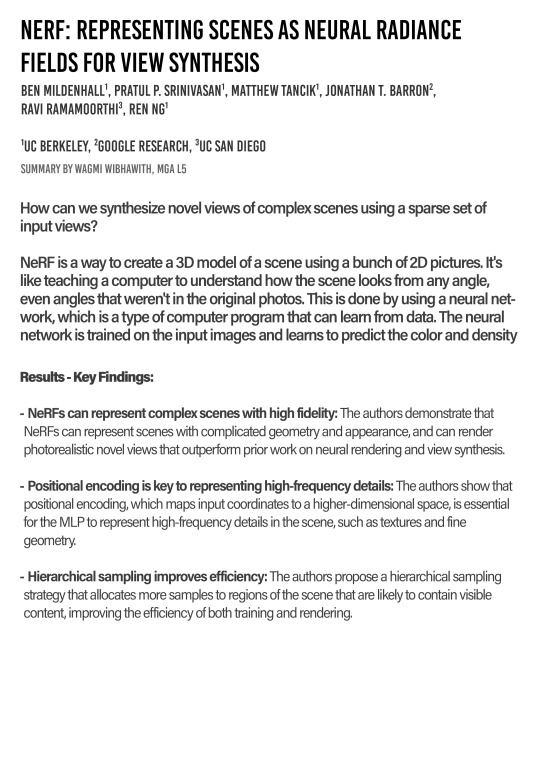
Mildenhall, B., Srinivasan, P.P., Tancik, M., Barron, J.T., Ravi Ramamoorthi and Ng, R. (2020). NeRF: Representing Scenes as Neural Radiance Fields for View Synthesis. arXiv (Cornell University). doi:https://doi.org/10.48550/arxiv.2003.08934.
0 notes
Text
Indepth Research: Photogrammetry
What is Photogrammetry?
According to the Canon Europe website, 3D photogrammetry is the process of creating a three-dimensional model from two-dimensional photographs. It involves taking multiple photos of an object from different angles, and then using specialized software to analyze the images and calculate the distances between points on the object's surface. This data is then used to construct a 3D model of the object.
The website emphasizes that photogrammetry can be used to capture a wide range of subjects, from small objects to large structures. It is a versatile tool that can be used in various industries, such as:
Art and entertainment: for creating realistic 3D models of characters, props, and environments
Healthcare: for creating accurate 3D models of patients' bodies, which can be used for surgical planning and other medical purposes
Manufacturing: for creating prototypes and inspecting finished products
Archaeology: for documenting and preserving historical artifacts
Overall, photogrammetry is a powerful technology that is becoming increasingly accessible and affordable. It has the potential to revolutionize the way we create and interact with 3D content.
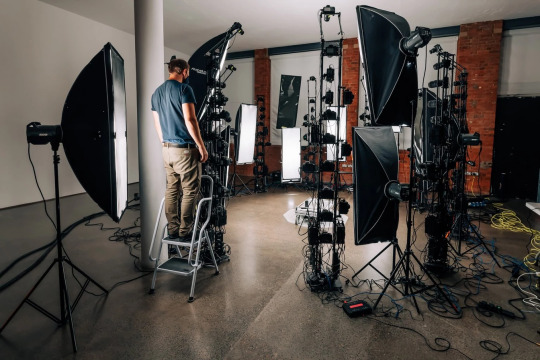
via 3D photogrammetry explained - Canon Europe (canon-europe.com)

via vfxpro-debevec-photogrammetry-20001120a.pdf (pauldebevec.com)
Masson, T. (2000). Paul Debevec and the Art of Photogrammetry. [online] Available at: https://www.pauldebevec.com/Items/VFXPro-20001120/vfxpro-debevec-photogrammetry-20001120a.pdf [Accessed 21 Jul. 2024].
0 notes
Text
Research: Practical Effects
What is Practical Effects/Production?
Practical effects include but are not limited to: props, sets, creatures, vehicles and makeup. Practical effects, a subcategory of visual effects, are always made by hand and are never computer generated. They add a sense of realism to a special effects-driven story, because they are real. A 3D object has weight and dimensions that actors can interact with. While some CGI ages poorly over time, practical effects done right can hold up for decades.
via Practical Effects in Film — How Filmmakers Do It For Real (studiobinder.com)

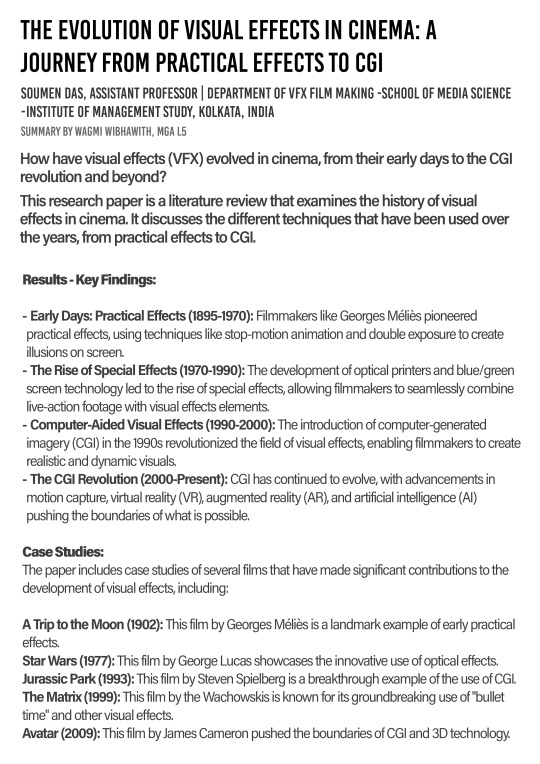

"THE EVOLUTION OF VISUAL EFFECTS IN CINEMA: A JOURNEY FROM PRACTICAL EFFECTS TO CGI", International Journal of Emerging Technologies and Innovative Research (www.jetir.org | UGC and issn Approved), ISSN:2349-5162, Vol.10, Issue 11, page no. ppe303-e309, November-2023, Available at : http://www.jetir.org/papers/JETIR2311442.pdf
0 notes












